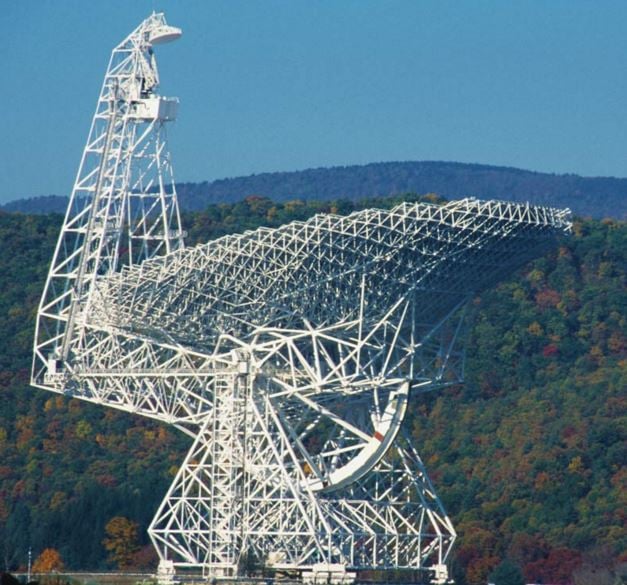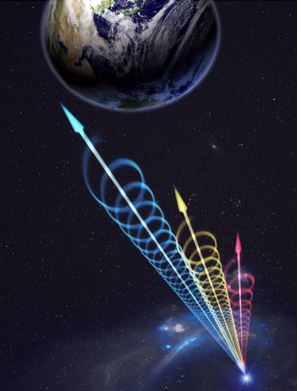The fast radio burst mystery which has baffled scientists for the past ten years may be finally solved, a team of astronomers and astrophysicists believes. Although they appear to come from the distant Universe, until now nobody had any idea how they were formed or where they came from.
Astronomer, Kiyoshi Masui, from the University of British Columbia and the Canadian Institute for Advanced Research, and colleagues poured over 650 hours of archival data from the National Science Foundation’s Green Bank Telescope and uncovered the most detailed record yet of a fast radio burst (FRB).
The scientists wrote about their study in the academic journal Nature.
 An artist’s impression of an FRB reaching Earth. The colors represent the burst arriving at different radio wavelengths, with long wavelengths (red) arriving several seconds after short wavelengths (blue). This delay, called dispersion, occurs when radio waves travel through cosmic plasma. (Image: public.nrao.edu. Credit: Jingchuan Yu, Beijing Planetarium)
An artist’s impression of an FRB reaching Earth. The colors represent the burst arriving at different radio wavelengths, with long wavelengths (red) arriving several seconds after short wavelengths (blue). This delay, called dispersion, occurs when radio waves travel through cosmic plasma. (Image: public.nrao.edu. Credit: Jingchuan Yu, Beijing Planetarium)
Their research suggests that the FRB originated inside a very-highly magnetized region of space, perhaps linking it to a recent *supernova or the inside of an active star-forming nebula (cloud of dust or gas).
*A supernova is a star that suddenly greatly increases in brightness, because of a catastrophic explosion that ejects most of its mass.
Dr. Masui said:
“We now know that the energy from this FRB passed through a dense, magnetized region shortly after it formed. This significantly narrows down the source’s environment and type of event that triggered the burst.”
FRBs last only a fraction of a second, but pack a colossal amount of energy. They are brief radio flashes of unknown origin that seem to come from random directions on the sky.
Although just a handful of them have been documented previously, scientists believe that the observable Universe is full of them – that there are thousands of these events on a daily basis.
Sophisticated software used to find elusive nugget
The scientists found the recently-identified FRB, called FRB 110523, by using a highly-specialized software that Dr. Masui developed with colleague Jonathan Sievers, who works at the University of KwaZulu-Natal in Durban, South Africa.
They had a phenomenal analysis challenge – 40 terabytes of recorded data – which was made even harder because the otherwise short, sharp signal of an FRB gets ‘smeared out’ in frequency as it travels through space.
 Data from the Green Bank Telescope contain the telltale signal of a Fast Radio Burst, suggesting that the event originated in a highly magnetized region of space. (Image: public.nrao.edu. Credit: NRAO/AUI/NSF)
Data from the Green Bank Telescope contain the telltale signal of a Fast Radio Burst, suggesting that the event originated in a highly magnetized region of space. (Image: public.nrao.edu. Credit: NRAO/AUI/NSF)
This smearing out of the radio signal, often referred to as dispersion delay, is frequently used to estimate distance in radio astronomy – the greater the dispersion, the further the object is from Earth.
In this case, the dispersion measure indicated that the FRB came from up to 6 billion light-years away.
Dispersion, however, can hide the presence of an FRB within archival radio data.
The new software, which counteracted the effects of dispersion, decreased the time required to analyze the data considerably.
The team members – mainly scientists with cosmology backgrounds – used the new software to conduct an initial pass of the Green Bank Telescope data to flag any candidate signal. This yielded over six thousand possible FRBs, which were inspected one-by-one by Hsiu-Hsien Lin, from Carnegie Mellon University in Pittsburgh. His analysis examined the field until just one candidate was left.
Details hidden in polarization
This single signal, however, was unique and contained more details about its polarization than any signal previously identified.
Before this one was detected, only circular polarization was associated with a Fast Radio Burst. This new study included a detection of both linear and circular polarization.
Professor Jeffrey Peterson, a faculty member in Carnegie Mellon’s McWilliams Center for Cosmology, said:
“Hidden within an incredibly massive dataset, we found a very peculiar signal, one that matched all the known characteristics of a Fast Radio Burst, but with a tantalizing extra polarization element that we simply have never seen before.”
Polarization indicates the orientation of the wave. It is a property of electromagnetic radiation, including radio and light waves. Polarizing sunglasses use this property to filter out a portion of the Sun’s rays – they are also used in 3-D movies to achieve an illusion of depth.
The team used this additional data to determine that the radio light from the FRB exhibited Faraday rotation, a magneto-optical phenomenon that rotates the polarization of light; a corkscrew-like twisting that radio waves acquire by passing through a very powerful magnetic field.
Dr. Masui said:
“This tells us something about the magnetic field that the burst traveled through on its way to us, giving a hint about the burst’s environment. It also gives the theorists a bit more to work with when they come up with explanations for these bursts.”
Measurements of the dispersion delay can also be used to place a lower limit on the size of the source region. In this case, the measurement ruled out models for FRBs involving stars in the Milky Way, and for the first time, showed that the FRB must have come from another galaxy.
Further analysis also showed that before reaching Earth, it also passed through two distinct regions of ionized gas, called screens.
The scientists were able to determine the relative locations of the two screens by using the interplay between them. The strongest screen is very close to the FRB’s source – within 100,000 light years – placing it inside the source’s galaxy. The researchers point out that only two things could leave such an imprint in the signal: 1. The environment near the center of a galaxy. 2. A nebula surrounding the source.
Dr. Masui concluded:
“Taken together, these remarkable data reveal more about an FRB than we have ever seen before and give us important constraints on these mysterious events. We also have an exciting new tool to search through otherwise overwhelming archival data to uncover more examples and get closer to truly understanding their nature.”
Citation: “Dense magnetized plasma associated with a fast radio burst,” Kiyoshi Masui, Hsiu-Hsien Lin, Jonathan Sievers, Christopher J. Anderson, Tzu-Ching Chang, Xuelei Chen, Apratim Ganguly, Miranda Jarvis, Cheng-Yu Kuo, Yi-Chao Li, Yu-Wei Liao, Maura McLaughlin, Ue-Li Pen, Jeffrey B. Peterson, Alexander Roman, Peter T. Timbie, Tabitha Voytek & Jaswant K. Yadav. Nature. 2 December, 2015. DOI: 10.1038/nature15769.
Video – Random appearance of FRB’s in the sky
This annimation illustrates the random appearance of Fast Radio Bursts on the sky (Credit: T. Jarrett (IPAC/Caltech); B. Saxton, NRAO/AUI/NSF).

